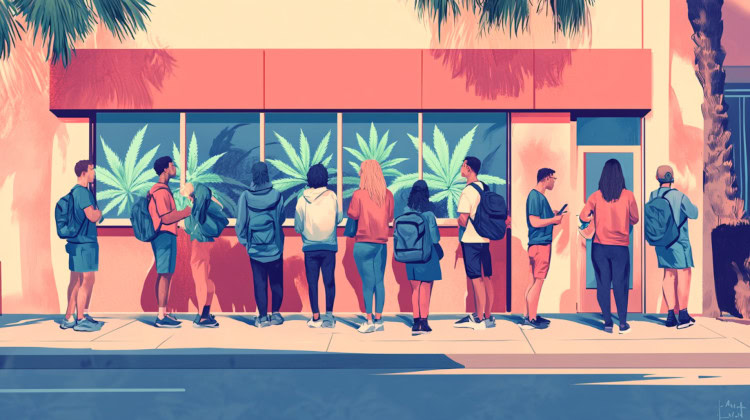The architects of Nixon-era drug policy that laid the foundation of today's overdose epidemic are still shaping national drug strategy in 2025.
In their newly released Blueprint for Effective Drug Policy, the Foundation for Drug Policy Solutions (FDPS) presents itself as a proponent of science-based reform. But the document openly advocates for forced treatment in drug courts, recriminalization of cannabis, and a return to strategies that long ago proved deadly.
This should worry every cannabis patient and advocate, even those who aren't using cannabis for opiate addiction or non-opiate pain control, because legal medical cannabis is caught directly in the crosshairs of this massive anti-reform whitepaper.
Critique in Brief
- Pharma Bias. The Blueprint elevates medication-assisted therapies like Suboxone as the gold standard, excluding potentially safer or less addictive alternatives despite mounting evidence for harm reduction value.
- Coercive Treatment. It promotes court-mandated substance abuse treatment without patient consent, which has been shown to increase overdoses, not decrease them.
- Harm Reduction Hostility. Harm reduction tools like fentanyl test strips are downplayed or dismissed, despite widespread international adoption.
- Cannabis Suppression. Cannabis and its derivatives are framed as dangerous, unregulated threats rather than therapeutic tools. The document calls for Congressional crackdowns on hemp and Schedule I reform efforts.
- Legacy Policymakers. Figures like Robert DuPont—central to the original War on Drugs—remain influential, reinforcing outdated ideologies that contributed to today's staggering overdose epidemic.
About the Foundation for Drug Policy Solutions
FDPS was founded by Kevin Sabet, a longtime opponent of cannabis reform. His other anti-cannabis brand, Smart Approaches to Marijuana, came under fire in 2016 after defending a $500,000 anti-legalization donation from Insys Therapeutics, the disgraced and now defunct opioid manufacturer behind fentanyl-based Subsys. At the time, Insys was lobbying against cannabis legalization in Arizona while developing Syndros, a synthetic THC product. Several of their executives were later prosecuted for racketeering and improper promotion of their opiate-based drugs.
Sabet moved on to create FDPS. Though framed as a public health initiative, the Blueprint reinforces the same anti-reform ideology: criminalization, coercion, and pharmaceutical control are preferable to plant-based autonomy, even when the latter has demonstrated fewer risks for an at-risk patient.
This discrepancy reveals a deeper bias: when the treatment is profitable (think forced detox centers or labor programs), or pharmaceutical and patentable, FDPS recommends that it be made mandatory. But for cannabis, even evidence-backed harm-reduction is sidelined in favor of stigmatization.
The Obvious Irony of This Policy
This policy is full of problematic recommendations, but the most dangerous is the support of forced substance abuse treatment in drug courts.
Studies show that involuntary detention results in a 27 times higher rate of overdose death in the first two weeks following release. Forced judicial intervention is not an evidence-based recommendation. It's dangerous and profit-driven.
The same system that stigmatized opioid users for decades now mandates their forced medication-free detox or forced dependence on state-sanctioned opioids (still associated with thousands of overdose deaths per year) while dismissing cannabis as illegitimate, even when it offers a safer path for some patients.
But the problems with the policy implications of this FDPS document run far deeper, and carry perhaps more severe consequences for patients. There is a distinct disregard for informed consent in favor of a state-mandated, one-size-fits-all “solution” for addiction (one that just happens to be highly profitable).
Yes, cannabis has the potential to be profitable too if regulations ever allow it. The difference is that we don't see cannabis activists advocating for court-mandated cannabis administration without consent.
The disregard for informed consent and patient choice in the FDPS’s proposed policy is alarming and has serious implications for patients who prefer to use cannabis specifically to avoid opiates or reduce dependence.
The Problem with Mandated Medication-Assisted Therapy
This new policy document heavily leans on drug courts as an option for drug offenders. While drug courts can offer a welcome alternative to imprisonment for some, forced drug interventions can create increased risk for others. What most Americans don’t know is that forced judicial interventions have already been associated with more death, not less. After forced incarceration we see a 27-fold increase in overdose death for the first two weeks and a 15-fold increase in overdose death for a full year. This risk is 43 times higher when the patient is denied medication-assisted therapy.
FDPS attempts to address this problem by recommending buprenorphine administration during forced SUD treatment and incarceration. The problem is that forced intervention in general is dangerous, with or without drugs. This raises profound ethical concerns. People in these programs often face imprisonment or loss of parental rights if they refuse intervention, including pharmaceuticals, regardless of personal medical history or risk factors.
While Suboxone is safer than full opioids, it still poses potentially fatal risks, particularly for polydrug users, the very people most likely to appear in drug courts. Courts mandate programs that require buprenorphine while failing to acknowledge that they are giving this respiratory depressant to a person with substance use disorder in an environment where other respiratory depressants like alcohol are easily accessible. According to data from 32 U.S. jurisdictions, over 92.7% of buprenorphine-involved overdose deaths involved at least one other substance.
Even beyond polydrug interactions, some patients have died from buprenorphine alone, often due to dosing errors, improper re-initiation after abstinence, or individual sensitivity to the drug itself. Buprenorphine-involved overdose deaths account for 2.2% of all drug overdose deaths and 2.6% of opioid-involved overdose deaths.
That’s not to say buprenorphine can’t be effective for some patients, but it is a substantial risk in mandated treatments, a risk that isn’t being acknowledged or addressed with the transparency and urgency patients deserve. These are not just clinical oversights, they are systemic failures with fatal consequences.
FDPS's recommendation to continue forced intervention isn't just misguided; it could be deadly.
Why This Policy Document is Truly Staggering
Cannabis, which has caused no undisputed fatal overdoses, is painted as a lethal threat, while lifetime opioid dependency, so long as it's in the form of Suboxone or methadone, is held up as "recovery," even knowing that the patient is still at risk of fatal overdose in any forced-treatment regimen.
The promotion of medication-assisted therapy (MAT) is not the problem. The problem is that FDPS is attempting to build legal and institutional structures to force Suboxone in hopes it will reduce harms caused by forced intervention while restricting potentially safer alternatives.
This isn’t drug policy reform. It’s ideological retrenchment backed by corporate interests, disguised as science.
Recent studies show that opiate overdose deaths are lower in U.S. counties with cannabis dispensaries. Statistics reveal a 17% decrease in counties with one dispensary and a 21% decrease in counties with two dispensaries. Correlation isn’t causation, but an overwhelming number of anecdotal reports support this correlation, and cannabis is now offered as treatment for opioid use disorder (OUD) in several states due to findings like this.
Instead of expanding access or study, the Blueprint that FDPS is proposing seeks federal crackdowns on THC, Delta-8, and even CBD-adjacent hemp products.
Meanwhile, it champions the idea that the only legitimate treatments for OUD are forced interventions that can be sold, billed, and lobbied for -- misguided propositions that have been proven to increase overdose deaths.
Can We Learn From History?
The Blueprint for Effective Drug Policy represents a repackaged war on cannabis and personal autonomy. It’s a document that vilifies cannabis, discredits alternative methods of harm reduction, and quietly endorses court-mandated pharmaceutical dependence as a public health win.
There is no public health benefit in forcing people into failed interventions that perpetuate the opiate overdose crisis. There is no safety in silencing alternative therapies with the potential to save lives. And there is no science in policy designed to protect markets, not people.
Keep up with your state's cannabis laws and regulations, and sign up for NuggMD's Weekly Sesh newsletter for consumer stories, tips, and analyses on how changing regulations and resources may impact patients.
The information in this article and any included images or charts are for educational purposes only. This information is neither a substitute for, nor does it replace, professional legal advice or medical advice, diagnosis, or treatment. If you have any concerns or questions about laws, regulations, or your health, you should always consult with an attorney, physician or other licensed professional.




